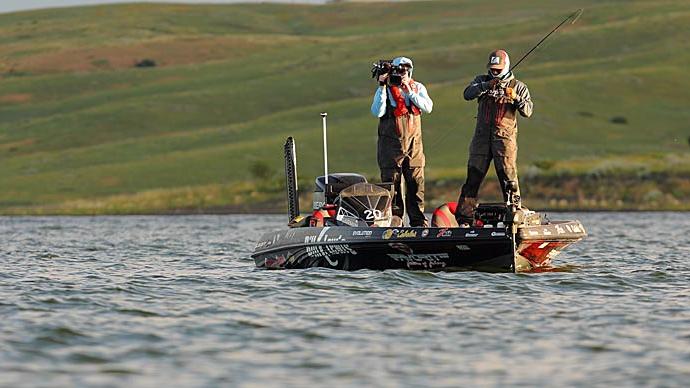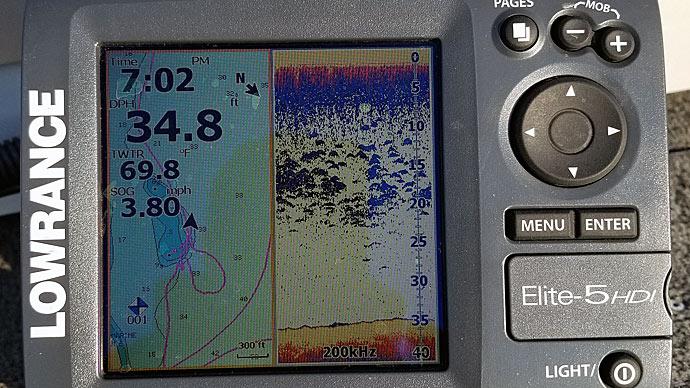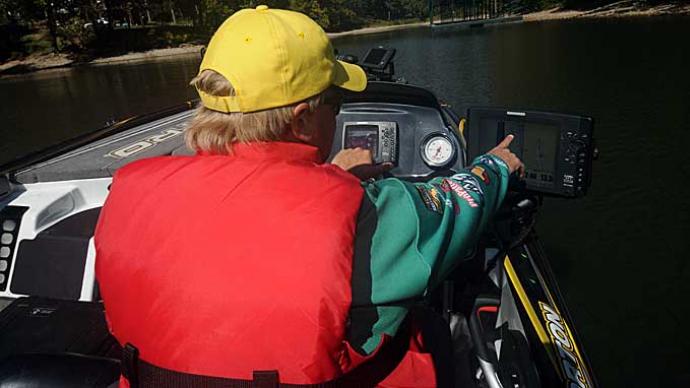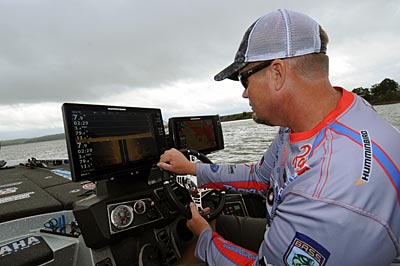
The shallower you fish, the less you should have to rely on your electronics as your underwater eyes.
After all, you should be able to see bass and their hideouts with your own eyes when you fish in shallow water.
That is true in some cases, but Bassmaster Elite Series pro Keith Combs still heavily depends on his Humminbird Helix 12 CHIRP MEGA units on his console and front deck almost any time he is fishing less than 10 feet deep. He does turn off his electronics whenever he is sight fishing or fishing in shallow clear water. “If I am in 4 feet of water and can see everything out there, that is a situation where I am not going to need my electronics for anything, but any time I can’t see the bottom, then it is my eyes,” he says.
The Texas pro notes there are some differences you need to consider when using electronics in the shallows compared to deep water scanning. “The main change is looking for fish on conventional sonar or down imaging. When you are in 15 to 20 feet of water or deeper, you get a broad view of the bottom, but when you get down to 10 feet, you have such a small slice of water you are looking at,” he says. Combs switches his units to side imaging and Humminbird’s 360 Imaging to get a broader view of the shallows.
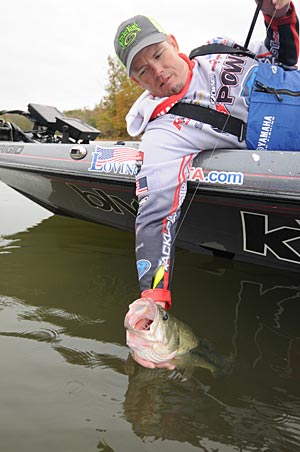
When idling with his outboard in the shallows, Combs relies on his console units' mapping and side imaging as his scouting tools. What he is looking for while scanning depends on the season. “Once we get into that postspawn or summertime mode, I am almost always looking for schools of bass,” Combs says. “You will see fish. Later in the year, it becomes easier to see the fish because they are in groups and cannot hide.
“During the prespawn and spawn, I am often just looking for cover that will hold the fish, which could be isolated stumps. During that time of year, you are not dealing with a big school of fish, so it is not as easy to pick them out. So I am looking for isolated cover (wood, rock, or grass) or hard spots, which shows well on side imaging.”
If Combs finds a stump with his side imaging but doesn’t see a bass on the screen, he still fishes the cover because a bass undetected by his electronics could be lying on the bottom. Combs will mark it as a waypoint if the stumps fails to produce a fish because he thinks a bass might use it as cover later.
Scanning for baitfish is another way Combs uses his electronics in the shallows. “That is the thing that will never hurt your area; baitfish will only enhance it,” Combs says. The Texas pro recalls in this year’s Bassmaster Classic he found shallow baitfish with his electronics and his own eyes in an area that produced quality bass for him on the second day of competition. “I knew bass would show up in that area and get active, and they did,” says Combs, who finished 14th in the Classic with 45 pounds, 15 ounces.
When using side imaging in the shallows, Combs scans both sides of the boat and sets the side imaging range to 80 feet. He tones down the sensitivity to one or two numbers below the factory settings and will tone it down even more if he is scanning a hard bottom.
Combs knows shallow bass are “very cover oriented,” so he scans for cover with 360 imaging when he moves to the front deck. “Everybody goes down the bank and picks them off on the visible stuff, but if you get on a flat, the 360 offers up a whole new world because you are precision fishing for things that no one else can unless they run 360,” Combs says. “It’s amazing how many more fish it puts in the boat for me.”
The two–time B.A.S.S. winner also detects bass and bream beds with his 360 viewing. “I also see a lot of beds, sometimes bass beds,” Combs says. “That is an overlooked little pattern for 360. A lot of times, what shows up well, and I catch a lot of fish in that postspawn, is bream beds. I can’t tell you how many times I have seen a bream bed in a totally obscured place where I would have never cast and caught a real key fish. Sometimes I have even seen bass on the bream bed and been able to catch everything that was there.”
When he scans the shallows with 360, Combs narrows the sweep area of imaging to the front and sides of the boat rather than the 360-degree view. “I typically zoom it in four times, so I am getting a big picture of what is around me,” Combs says. “I also slow the sweep speed down to 2, which gives me better clarity.”
Although he believes bass can become wary of the pings of electronics and get tight-lipped, he will still run his units most of the time in shallow water. “I try to keep my sounds to a minimum whether it is the boat or sonar,” he says. “You just have to weigh the advantages of whether or not it is worth running your electronics then.”


